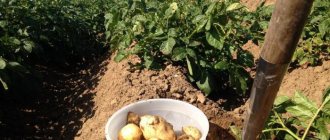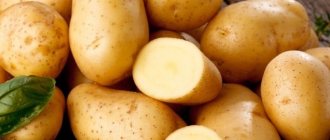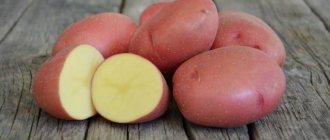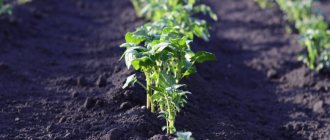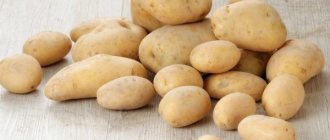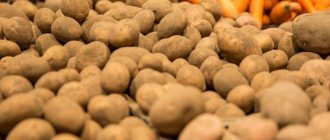Features of planting tubers
After the rows are ready, the planting tubers are laid out at the bottom of the grooves at a distance of twenty centimeters from each other (for early potato varieties) or twenty-five centimeters (for late ones). The potato sprouts should be facing down. Tubers planted in this way produce unthickened tops. Subsequent plant care is made easier and the risk of late blight is significantly reduced.
After all the planting material is laid out in rows, it is covered with humus or semi-rotted manure up to the top of the grooves. Potatoes love nutritious and light soil, so about a ton or more of organic fertilizer is needed per hundred square meters.
Cleaning and storage
2 weeks before harvesting, potato tops should be cut off with pruning shears or mowed and burned. It is recommended to wash the dug up potatoes intended for storage (and especially for planting), preferably even in a solution of potassium permanganate. This way you will remove all the pathogenic microflora that is necessarily present on potatoes.
When harvesting, the tubers may suffer scratches and other damage. When bacteria gets on them, the potatoes begin to rot.
You can store the harvest in the cellar (if the temperature there does not exceed 5 degrees) or in a shallow (knee-high) hole covered with polyethylene and earth (if the winters are not very cold). In a warm cellar, potatoes constantly germinate. By breaking off the sprouts, we take away part of the energy of the tuber, and the yield decreases accordingly.
For planting, it is better to select medium-sized tubers, preferably from bushes that had the largest harvest. Sorting is done immediately at the time of harvesting, while it is clear which bush the tubers come from.
As you can see, the result depends little on physical effort, the main thing is successful seed material and proven growing technology.
X
Recommendations from practitioners
Elite potatoes
The first secret was mentioned above; practitioners prove that if there is no high-quality planting material, it is better to refuse planting altogether, since there will not be high productivity.
To breed your stock, it is recommended to purchase elite seeds; they are healthy and not contaminated with viruses.
Such potatoes are sold by special horticultural retail outlets; they have the necessary documentation confirming the state of sanitary standards and the implementation of appropriate treatments.
These products are not cheap, but there are many ways you can propagate yourself and get enough rare tubers from several pieces of elite products to plant the required area.
The next secret to increasing productivity is shared by all rural residents; they will never plant potatoes in the same place and try to alternate vegetable planting plots. Large agricultural enterprises also use the method of changing places for planting crops, allowing the land to be cleaned of fungal and bacterial formations for 4 years.
Crop rotation of garden crops
One of the important points to consider is that planting should only be done on fertile soils. Potatoes require soil rich in minerals. Since ancient times, villages have stored animal waste products from cowsheds in heaps. Humus was scattered in the garden in the fall and plowed up.
Today there are opportunities to purchase compost from various organizations specializing in this area. This will help the farmer increase the fertility of his plot.
It is necessary to take into account the planting density between rows. Everyone knows the high fertility of Dutch potatoes. The Dutch plant root crops on their farms at a distance of 80 cm, bed from bed. In our gardens you will notice that the planting lines are close to 40 cm.
As a result:
- difficult to hill up a bush
- in many cases the root is cut
- the plant is stunted in growth
- tubers develop poorly
- there is a lack of hilling soil, the seeds become exposed and become unusable
A full harvest requires:
- The inter-row width of early potatoes is not less than 60 cm.
- the distance between the rows of late root crops should be 80 cm.
When performing any work, you need to follow the rules that have long been tested in practice. The basis of agriculture is the centuries-old experience of farmers around the world.
How to increase potato yield
In order to increase the potato yield, it is necessary to water it, hill it and weed it on time. But there are still some tricks that allow you to exceed the possible results from cultivating this crop.
Disinfection of planting material
Disinfection of seed material can improve its resistance to diseases and adverse factors. This procedure can be performed in two ways. One involves soaking the tubers for 2-3 hours in a special solution. The second involves spraying them with a spray bottle.
Recipes for disinfection solution:
- Garlic. 1 kg of crushed garlic is diluted in 10 liters of water.
- Nutritious. Mix 5 g of copper sulfate, 15 g of boric acid and 0.5 g of potassium permanganate. Pour in 10 liters of water.
- Superphosphate. 60 g of superphosphate, 40 g of urea, 5 g of copper sulfate, 1 g of potassium permanganate and 10 g of boric acid are dissolved in 10 liters of water.
- For spraying. Dilute 30 g of calcium sulfate, 40 g of urea, 15 g of boric acid, 1 g of copper sulfate and 0.5 g of potassium permanganate in water. Approximately 100 kg of potatoes will require 1 liter of solution.
On a note!
It is better to spray potatoes before the tubers have sprouted. If the roots have already appeared, then it is better to wait until the potatoes turn a little green and then apply an aerosol treatment. In this case, it is better to reduce the concentration of the solution by half.
Bathing in a nutrient solution
This method can increase productivity by 10-15%. For sprouted tubers, bathing is best done two days before planting in the soil. The nutrient solution will allow the root crop to form sprouts faster and speed up the germination of the tops.
Water the tubers with water with the addition of 40 g of superphosphate, 40 g of nitrogen fertilizers and 40 g of potassium salt. All ingredients are diluted in 10 liters of water. This is exactly the amount of solution needed for 50 kg of seed potatoes.
On a note!
It is better to bathe unsprouted tubers a day before planting in the soil.
Stimulating incision
This method will require an impressive amount of time. Therefore, it is advisable to use it when growing potatoes on a personal plot, where planting volumes are small. The use of cuts can increase potato yield by 12-13%. It is necessary to make cuts on the tubers in advance, even before germination. It is best to carry out this procedure 1.5-2 months before planting.
Transverse cut
This trick allows you to activate potato eyes not only in the upper part, but throughout the entire surface of the tuber. If you plant whole potatoes, only the top ones will sprout.
A cut is made across the potato. It is deep and bisects the tuber almost completely except for a small bridge about 1 cm wide.
This manipulation allows the nutrients in the seed to be distributed evenly. The result is a strong bush with a large number of stems from each tuber. For clarity, you can try cutting some of the seed potatoes in the country, and leaving some untouched, and then compare the results. Official experiments have shown up to a 20% increase in yield.
Circular cut
Such manipulation also stimulates the germination of eyes, which remain “dormant” under normal conditions. The procedure is carried out with a knife (it is more convenient to attach a limiter to it). An incision 1 cm deep is made across the entire surface of the tuber. To prevent the spread of diseases, the knife must be periodically disinfected in a light solution of potassium permanganate, and try to choose healthy tubers.
The incision can be made transversely or longitudinally. In the first case, the germination of the lower and lateral ocelli is stimulated. And in the second, they remain unused, but the upper ones grow faster.
On a note!
To obtain a high yield, it is necessary to keep the treated tubers warm for about a month. In this case, the ambient temperature should not drop below 14 ºС.
Proper watering
Potatoes are quite easy to care for and require almost no watering. It is enough to give it water 1-3 times a year. The right time is when the first shoots appear and buds set. If the weather is dry and there is almost no rain, then additional watering will certainly increase the potato yield.
On a note!
If the soil dries out by 7 cm or more, it is recommended to water the potatoes in order to preserve the harvest.
Top dressing
In order to get a larger potato harvest, it needs to be fed. In practice, people most often use manure, which is spread over the surface of the field before planting.
If there is little manure and you have to save it, you can place it directly in the furrows before planting.
May be interesting Potatoes "Bellarose" - tasty and fruitful Wisdom of pruning raspberries Caring for currants after harvest
A compost heap can be an excellent source of fertilizer. It is usually organized at a summer cottage. Throughout the year, grass and food waste are thrown into the compost. Special humus worms can speed up the process of fertilizer formation.
In order to increase the potato yield in your home garden, you can use a three-component fertilizer. It includes the following steps:
- 15 glasses of humus and 10 tsp. urea is mixed. This amount of fertilizer is enough for a 10 m furrow. This type of feeding will be most effective during the formation of stems. It will strengthen them and accelerate growth.
- 30 tbsp. l. ash and 10 tsp. calcium sulfate. Also enough for 10 meters of landing. Stimulates the formation of inflorescences. It is most effective to apply at the very beginning of flowering.
- To stimulate the formation of tubers, two recipes can be used. The first involves mixing 2 tbsp. l. superphosphate, 2 tbsp. l. potassium sulfate and 1 tbsp. l. nitrophoska per 10 liters of water. Each bush will require 0.5 liters of solution. The second is simpler, but also effective. Water the potatoes with a solution of 2 tbsp. l. superphosphate per 1 meter of furrow.
On a note!
You should avoid feeding potatoes with organic matter during flowering. This can cause disease outbreaks and increases grass growth.
Hilling
The traditional method of growing potatoes involves two hillings. It is produced using a plow or a special device by hand.
The plant is earthed for the first time after the first shoots appear. This should be done the second time when the stems stretch 20-25 cm. This technique will speed up the formation and growth of tubers, and will also allow you to get rid of weeds for a while.
Pest and disease control
To combat the mole cricket and the Colorado potato beetle, both traditional methods and various purchased insecticides are used. In the spring, when planting, traps are installed along the edge of the site and between the rows.
Take your choice of planting material seriously
Planting seed potatoes in the garden
After all, 50% of the harvest depends on what we plant.
I still remember how in my youth we selected potatoes for seeds. All the potatoes were dug up. Lay out to dry. Then the largest one was collected from this pile. Separately small and then seed. Don't ever do that . Don't take from the general heap. We won’t see what the potato bush was like. Maybe the tops are affected by late blight and in the future we will plant already diseased potatoes. Maybe only 2-3 eggs the size of an egg grew on it and we took them away. Next year, they will also grow 2 potatoes, and not a bucket from a bush. Therefore, take seriously the selection of potatoes for planting.
Potato planting rate per 1 ha
The traditional method of growing potatoes is to plant the tubers in rows. The width of the rows is 70-90 cm, the distance between plants in the row is 25-45 cm.
Expert opinion Ivan Yuryevich Filatov, private farmer for more than 30 years For example, on one hundred square meters (a plot of 10 × 10 m in size), with a distance between rows of 70 cm, approximately 14 rows are placed (taking into account the fact that the outer rows on the plot are located indented from border). If the distance between plants is 40 cm, then you can plant 25 tubers in a row. Therefore, 350 potatoes are required to plant 1 hectare. With a weight of seed tubers of 70-80 g, the total mass of planting material will be 27-28 kg.
Of course, in practice, seed tubers are calibrated with high accuracy only in specialized stores. Therefore, if planting material is taken from your own harvest, then it is necessary to take into account the error (as well as possible damage to the seeds in storage) and leave the seeds at approximately 28-29 kg per hundred square meters.
When marking the same plantation scheme, the hectare size will be 142 furrows, each with 250 bushes. This will take 35,500 seed tubers with a total weight of about 2.84 tons (in practice 2.8-2.9 tons).
Average potato yield per hundred square meters in the Moscow region
According to open data, in temperate latitudes and subtropics, potatoes ripen in 4 months and produce from 250 to 350 c/ha (1 ha = 100 acres, 1 c = 100 kg). Thus, in the best case, it turns out 350 kg per hundred square meters.
For large agricultural holdings in Russia this figure is about 250 kg per hundred square meters, for farms – only 170 kg per hundred square meters, and for private farms (dacha gardeners) – usually does not exceed 150 kg per hundred square meters. Moreover, the share of private household plots and small farmers in the market is about 85%.
In the Black Earth Region the indicators are slightly higher, and in the Central region – slightly below average. The norms for key regions are as follows:
- Moscow region - from 180 to 210 c/ha;
- Leningrad region and North-West - from 170 to 190 c/ha;
- Ural, Siberia - from 150 to 210 c/ha.
The conclusion is obvious: in order for a leading summer resident to collect a ton per hundred square meters, the yield must be increased by at least 7 times. For average gardeners, the real numbers will differ by an order of magnitude.
However, in our country there are individual agricultural enterprises in which, thanks to the introduction of the most advanced technologies (almost complete automation) and the selection of the highest quality seed material, it is possible to get close to the mark of 500 centners per hectare, which is still 2 times lower than what bloggers advise, talking about grandmother's methods and grandfather's proven methods.
In the world, the leaders in yield are the most developed countries: the Netherlands (450 c/ha), France (430 c/ha), Belgium and Germany (420 c/ha), Great Britain (405 c/ha), Spain (280 c/ha ), Italy (255 c/ha).
But all this does not really matter, because “When planting potatoes, my grandmother simply put a pinch of [substitute what is needed] in each hole.” The question is, where is this grandmother, where is this house? Was there a boy? The questions are rhetorical in nature.
Large harvest at the dacha
Of course, when starting to grow crops, a farmer dreams of a successful and large harvest.
However, not everyone knows how to grow a good harvest of potatoes that would be the envy of their neighbors in their summer cottage. In reality, taking care of the harvest is not a tricky matter; it is only advisable not to forget about your plantings and monitor them in a timely manner. For example, if you have already planted potatoes, but suddenly frost hits, you need to go to the dacha as soon as possible to hide the beds under plastic film and any other woven material that would protect the soil and seeds from freezing and death. In general, it is worth noting:
- The further you live from your dacha, i.e. The less opportunity you have to come to the dacha in a short time at any time, the later you should start planting potatoes.
Much depends on the region of your residence and its characteristics; in some places potatoes are planted as early as April, and in others closer to mid-May. The first harvest is obtained by mid-June - early July. Anyone can plant potatoes; much in this matter will depend on the planting method you choose:
- The classic shovel method. The most familiar option for Russian people and more developed. If the groundwater is close to the soil surface or the soil itself is quite dense, but you should not plant potatoes deeply, literally 5 cm deep will be enough. If the soil is light and there are no problems with groundwater, you can plant potatoes to the depth of a shovel;
- Using a walk-behind tractor. An excellent method for planting potatoes if you have a large plot of land. Otherwise, you will get more tired of changing the wheels and guides for the walk-behind tractor in order to create new beds, spread out potatoes, bury beds, etc. But you can’t handle a large plot manually without a walk-behind tractor;
- Under straw and hay. This option is suitable for less arid regions that are not prone to fires from drought and scorching sun. As a result, with minimal effort, you can grow good, large potatoes and in fairly large quantities.
In general, potatoes love air very much, which is why it is necessary - so do not try to dig seed potatoes as deep into the soil as possible. This is what our parents and our grandfathers have always done, but the fact is that it will be a mistake if you do not want to get an early potato harvest, even if it is small. In addition, seedlings must emerge quickly, which will affect the size of the crop. What other information about growing potatoes did you get from your ancestors?
- “You can cut potato tubers in half to save seeds and get more yield.” In fact, you should not do this, otherwise the cut seeds may rot or become diseased. If you have very dry soil and you don’t have the opportunity to water it abundantly, then this option may well work.
- “Store-bought potatoes are bad, they are stuffed with all sorts of chemicals.” Absolutely, but this does not mean that potatoes are harmful to health. The fact is that modern summer residents also use growth stimulants to obtain a larger harvest or chemicals to protect potatoes from pests.
You should also not forget about the biggest scourge of the potato field - the Colorado potato beetle. Unfortunately, it is found in any area, and the best way to get rid of it is constant struggle! And how to grow a large harvest of potatoes without forgetting about caring for them? It will be necessary to spray the tops, collect beetles by hand, and feed the soil for protection. In specialized stores, purchase proven and safe pest control products and use them.
What can you do to increase your profitability?
One way to increase profits from growing potatoes is to build your own vegetable storage. Undoubtedly, this will raise start-up costs to another level, but they will be very profitable and will quickly pay for themselves.
Potatoes cost much less immediately after harvest than when supplies are already running out. Thus, for a kilogram of potatoes you will be able to get more money than in the fall. In addition, part of the premises can be rented out, which is another plus. But keep in mind that the vegetable storage facility must meet all sanitary standards and have optimal storage conditions for the crop.
Another good thing about potatoes is that both the tops and roots are used. Agree with livestock farms; they will be happy to take the tops for animal feed. Of course, it doesn’t cost much, but with large volumes it will add up to a good amount.
After you return the invested funds and receive the first net profit, it makes sense not to spend it right away. Consider opening your own processing plant. This could be a plant for the production of frozen potatoes, or potato flour, again starch. This way you will get rid of the headache of selling products, or parts of them, but will be able to significantly increase your income. Good luck in your endeavors!
Ways to increase potato harvest
Many fertilizers have a significant impact on vegetable yield. This refers to the addition of fertilizers directly during the process of planting tubers in the holes. This is much easier than finding out later what exactly the plant lacks and having to feed it numerous times. Common fertilizers for potatoes:
| Fertilizer brand | Description, composition |
| Superphosphate | Mineral complex |
| Ammonium nitrate | Nitrogen-containing growth agent |
| Pixa Super Compost | Active feeding with an abundance of beneficial microorganisms |
| Kemira-Lux | Complex content product (phosphorus – 20%, potassium – 27%, nitrogen – 16%) |
All these fertilizers help plant organisms absorb the necessary substances. They are able to increase the productivity of vegetables by 1.5-2 times or more. Biostimulants are natural or synthetic substances. Using which, even in a small dose, impressive progress in the development and growth of vegetable crops is observed.
When these compounds enter the structure of the plant, they purposefully join the metabolic process, influencing it and increasing the level of vital activity of the crop. List of stimulants that are used when growing potatoes:
| Name | Description |
| Gibbersib | A well-known stimulant for plant development. It increases the productivity and quality of vegetable, berry and fruit crops. Due to the pre-sowing treatment of potatoes using this product, the yield increases from 20 to 30% |
| Epin and Silk | These are phytohormones that stimulate the appearance of stress proteins. They protect the culture from a number of harmful influences. As a result, the plant begins to develop much more efficiently |
Recommendation: a simple folk method for increasing productivity
If the plants are planted near a compost heap, it grows incredibly strong and powerful. Potato bushes are no exception. For example, put cut flower stalks, mown grass, weeded weeds on each row-spacing, and sprinkle everything on top with old sawdust. In this method, the soil will be additionally filled with humus, since nutrients are not superfluous.
What fertilizers should be used
A good harvest cannot be obtained without the use of various means that affect plant growth, quality and quantity of fruits. Technologists have developed many fertilizer compositions and tried to eliminate harmful substances from them; you just need to act strictly according to the instructions. There are many recommendations for independently preparing the desired composition. Usually the product is poured directly into the hole when planting vegetables.
It is not difficult to make a biological fertilizer at home called Urgasa with the addition of Baikal - EM1. Food waste is stored in a plastic bag, sprinkled with sawdust, and with the help of a bacterial concentrate, it will disintegrate, and the smell will also be destroyed.
Adding a handful of the resulting substance to the hole, mixed with soil, significantly increases the yield, the tops grow actively, and large tubers are formed.
Supercompost
Owners of mass potato plantings respond well to Pixa active fertilizer.
It contains beneficial microorganisms, the purpose of which is to increase the ability of plants to absorb nutrients.
The vegetable yield increases, only large root crops are obtained, and the bushes are green.
The substance should be poured directly into the dug planting hole in accordance with the attached instructions.
Domestic potato growers use Finnish complex fertilizers from the Kemira category.
The use of such means can significantly increase fruit yield, this has been proven by experiments on the fields of large farms, as well as on private sector plots. Potatoes improve their quality characteristics by increasing their starch content.
